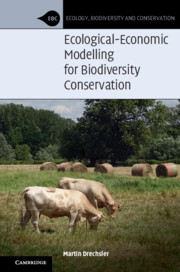Book contents
- Ecological-Economic Modelling for Biodiversity Conservation
- Ecology, Biodiversity and Conservation
- Ecological-Economic Modelling for Biodiversity Conservation
- Copyright page
- Contents
- Preface
- Acknowledgements
- Part I Modelling
- 1 What Is a Model?
- 2 Purposes of Modelling
- 3 Typical Model Features
- Part II Ecological Modelling
- Part III Economic Modelling
- Part IV Ecological-Economic Modelling
- References
- Index
2 - Purposes of Modelling
from Part I - Modelling
Published online by Cambridge University Press: 29 February 2020
- Ecological-Economic Modelling for Biodiversity Conservation
- Ecology, Biodiversity and Conservation
- Ecological-Economic Modelling for Biodiversity Conservation
- Copyright page
- Contents
- Preface
- Acknowledgements
- Part I Modelling
- 1 What Is a Model?
- 2 Purposes of Modelling
- 3 Typical Model Features
- Part II Ecological Modelling
- Part III Economic Modelling
- Part IV Ecological-Economic Modelling
- References
- Index
Summary
Taking up the definition of a model posited in Chapter 1, models can follow different purposes. This chapter introduces nine general purposes: theory development, generalisation, theory testing, understanding (of systems and their dynamics), explanation (of observed phenomena), prediction (of the system dynamics), decision support (for the derivation of ‘good’ policies and strategies), communication (of knowledge and information) and education (of students and young researchers); and two more technical purposes: integration of knowledge and mediation between scales. These eleven purposes are demonstrated using modelling studies from the literature in the disciplines of physics, ecology and economics. Further, a model may be general or specific, and it may be used for positive analysis (‘what is’) or normative analysis (‘what should be’), or a mixture of both.
Keywords
- Type
- Chapter
- Information
- Publisher: Cambridge University PressPrint publication year: 2020

